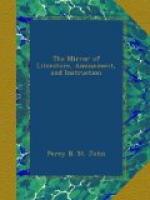After the defeat of the Spanish Armada, the association soon fell to decay. The ground they used was at the north extremity of the city, nigh Bishopsgate, and had before been occupied (says Ellis) by the “fraternity of artillery,” or gunners of the Tower.
From the company’s register, the only book they saved in the civil wars, it appears that the association was revived in the year 1611, by warrant from the privy council; and the volunteers soon amounted to six thousand. In the year 1640, they quitted their old field of discipline, and entered upon a plot of ground in Bunhill-fields, leased to them by the city.—(See Ellis’s History of Shoreditch, and Nicholson’s London Artillerie.)
In the thirteenth year of the reign of Henry VII. “All the gardens which had continued time out of mind without Moorgate: to wit, about and beyond the lordship of Fensberry (Finsbury) were destroyed: and of them was made plain field for archers to shoote in.” This was the origin of what is now called the Artillery Ground. P.T.W.
* * * * *
HINDOO BURIAL SERVICE.
During the funeral ceremony, in some parts of Hindostan, the Brahmins address the respective elements in words to the following purport:—
“O Earth! to thee we commend our brother; of thee he was formed, by thee he was sustained, and unto thee he now returns!
“O Fire! thou hadst a claim in our brother during his life; he subsisted by thy influence in nature, to thee we commit his body, thou emblem of purity, may his spirit be purified on entering a new state of existence!
“O Air! while the breath of life continued, our brother respired by thee; his last breath is now departed, to thee we yield him!
“O Water! thou didst contribute to the life of our brother, thou wert one of his sustaining elements. His remains are now dispersed, receive thy share of him, who has now taken an everlasting flight.” SWAINE.
* * * * *
ORIGIN OF THE ACADEMY DELLA CRUSCA.
Crusca is an Italian term, signifying bran, hence the name Academy della Crusca, or the Bran Academy, which was established at Florence, for purifying and perfecting the Tuscan language; it was formed in the year 1582, but scarcely heard of before the year 1584, when it became noted for a dispute between Tasso and several of its members. According to its origin, its device is a sieve, and its motto, Il piu bel fior ne coglie; that is, It gathers the finest flour thereof.
In the hall or apartment where the Academy meets, every thing bears allusion to the name and device: the seats are in the form of a baker’s basket; their backs like a shovel for moving of corn; the cushions of grey satin in form of sacks, or wallets; and the branches, where the lights are placed, likewise resemble sacks. This Academy is now united with two others, viz. the Fiorentina, and the Apatisti, under the name of Reale Accademia Fiorentina.




